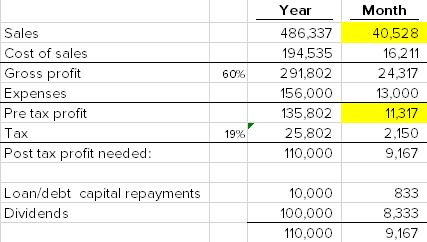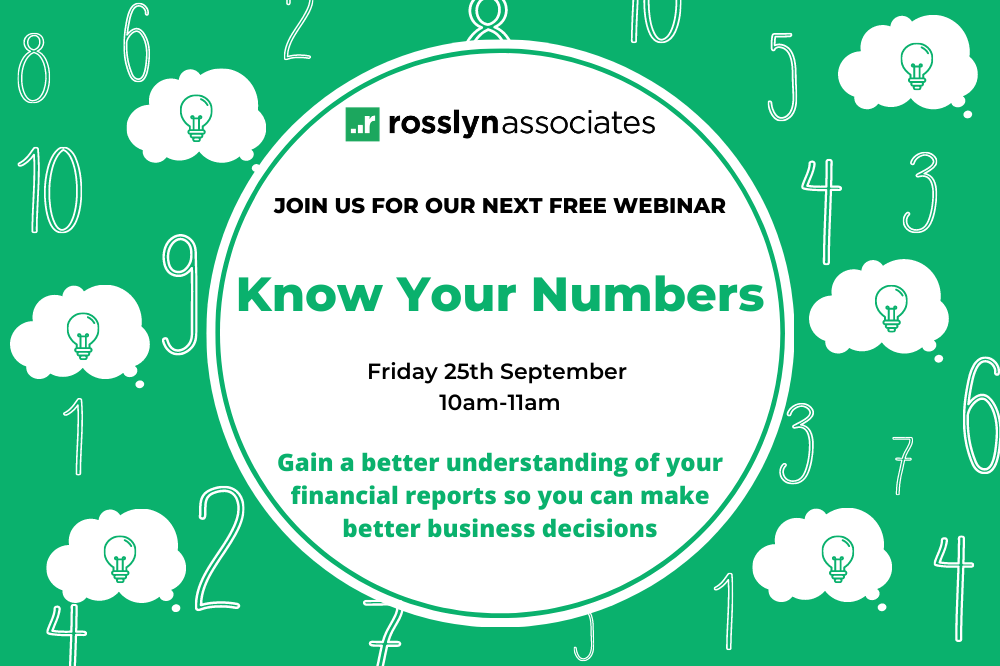
How much do you need to sell to avoid running out of cash?
It’s often thought that as long as your business is showing to be making a profit in your profit and loss (P&L) account, everything is great, your business is profitable, and you can take home cash. However, this isn’t strictly true. There are other things you need to take into consideration and further costs that need covered.
Read on to learn how to work out the level of sales your business needs to make, to cover all costs, taxes, & loan repayments, leaving enough cash to cover the drawings you wish to take. To do this, we use a technique called bottom up budgeting.
Gross profit Vs Pre Tax Net Profit Vs Post Tax Net Profit
It’s important to understand the difference between gross profit, pre tax net profit, and post tax net profit. Just because your P&L shows you are making a profit, it doesn’t mean you are actually left with any cash in your business.
Gross Profit – This is your total turnover (sales), minus the costs of the goods you’ve sold.
Pre tax net profit – This is the figure you have left after you take away all expenses such overheads, interest on loans etc.
Post tax net profit – This is your pre tax net profit, minus taxes. This figure must be a large enough sum to cover any loan/debt capital repayments and any dividends you wish to take from the business.
What is bottom up budgeting?
Bottom up budgeting is working backwards. Starting from the amount of cash you need in order to pay any loan capital repayments and the level of dividends you want to take, then working out what sales you’ll need to get there, taking into consideration the different costs, taxes and drawings along the way. This will result in a sales target which you know you’ll have to reach for the desired results. This will help with making decisions and you’ll know if you’re on track. Let’s look at an example to show how it works:

1.Post tax profit
Bob knows he has £10,000 in loan capital repayments to cover, and that he also would like to take £100,000 in dividends. This means that the minimum post tax profit that Bob needs to make is £110,000. But how much does he need to sell to get there?
2. Pre tax profit
Next, he needs to work out his pre tax profit. He does this by grossing up his post tax profit of £110,000, by 19%, which gives a pre tax profit him £135,802 (and a tax bill of 25,802).
3. Gross Profit
Next, Bob needs to look at his gross profit. He knows his expenses for the year, such as overheads, interest etc. are £156,000 this means that in order to be left with the £110,000 he needs to cover dividends and loan capital repayments, he will need to make a gross profit of £291,802 (£110,000 + £25,802 +£156,000).
4. Sales target
Bob knows that his gross profit percentage is 60%, and that his gross profit is £291,802. Therefore, he can now work out the sales he needs to make the necessary profit. (291,802 x 100 / 60= £486,337) with the remaining £194,535 being his cost of sales.
5. Monthly targets
He can then divide his calculations by 12 so there is a clear monthly sales target to measure results against.
Building reserves to cover the unexpected
This example shows the minimum sales necessary to cover all costs and to allow Bob to take the level of dividends he would like. However, ideally, the business would make more profit than this, so it builds up extra cash reserves. Having reserves in the business allows back up in case things unexpectantly don’t go to plan (e.g. lessening the impact of coronavirus) or in a more positive light, if an opportunity comes along, which needs cash investment, you have the reserves to go for it.
We can help you
If you want to try bottom up budgeting for your business, have a go! If you would like some support, get in touch, and if you have any questions please send us an email to info@rosslynassociates.co.uk. We provide a range of services for owner managed businesses to help them develop and grow, so you can get what you want from your business.
Also, check out our events page here. We host monthly seminars to help business owners grow more successful businesses. Giving them more time, more money, and less stress. Join us for our next event!
If you missed our previous webinars, you can now access them here!





